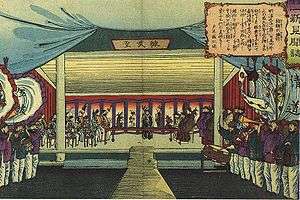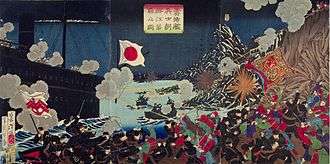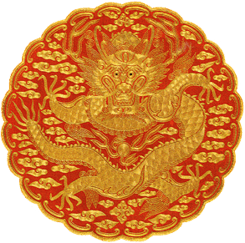Japan–Korea Treaty of 1876
| Japan-Korea Treaty of Amity | |||||||
 | |||||||
| Japanese name | |||||||
|---|---|---|---|---|---|---|---|
| Kanji | 日朝修好条規 | ||||||
| Hiragana | にっちょうしゅうこうじょうき | ||||||
| |||||||
| Korean name | |||||||
| Hangul | 강화도 조약 | ||||||
| Hanja | 江華島條約 | ||||||
| |||||||
The Japan–Korea Treaty of 1876, also known as the The Japan-Korea Treaty of Amity in Japanese or Treaty of Ganghwa Island in Korean, was made between representatives of the Empire of Japan and the Joseon Kingdom in 1876.[1] Negotiations were concluded on February 26, 1876.[2]
Background
After the Industrial Revolution in the 18th century, European nations began to colonize many other nations in Africa and Asia under the political ideology known as Imperialism. Almost all of Africa was colonized by European Powers; most of Central, South and Southeast Asia including India were taken over by various European nations. East Asia also was invaded by foreign powers, beginning with the First Opium War (1839–1842) and Second Opium War (1856–1860) against China fought by Britain and other western powers; China's empire was reduced to a half-colonized territory. Meanwhile, the American Asiatic Squadron under the leadership of Matthew C. Perry forced Japan to open its ports to the western world in 1854.[3]
Humiliated by unequal treaties and the prospect of losing its independence and integrity to imperialist powers, Japan embarked on a rapid transformation, successfully turning itself from a medieval society into a modern industrialized state.
Ganghwa incident


In Korea, the strong dictatorship of Heungseon Daewongun was overthrown by Queen Min, who instituted a policy of closing doors to European powers. France and United States had already made several unsuccessful attempts to begin commerce with the Joseon dynasty, all of them happening during Heungseon Daewongun's era. However, after he was removed from power, many new officials who supported the idea of opening commerce with foreigners took power. While there was political instability, Japan developed a plan to open and exert influence on Korea before a European power could. In 1875, their plan was put into action: the Un'yō, a small Japanese warship under the command of Inoue Yoshika, was dispatched to survey coastal waters without Korean permission.
On September 20, the ship reached Ganghwa Island, which had been a site of violent confrontations between Korean forces and foreign forces in the previous decade. In 1866, the island was briefly occupied by the French, and also in 1871 subject to American intervention. The memories of those confrontations were very fresh, and there was little question that the Korean garrison would shoot at any approaching foreign ship. Nonetheless, Commander Inoue ordered a small boat launched – allegedly in search of drinkable water. The Korean forts opened fire. The Un'yō brought its superior firepower to bear and silenced the Korean guns. Then it attacked another Korean port and withdrew back to Japan.
Treaty provisions

Japan employed gunboat diplomacy to press Korea to sign this unequal treaty. The pact opened up Korea, as Commodore Matthew Perry's fleet of Black Ships had opened up Japan in 1853. According to the treaty, it ended Joseon's status as a tributary state of Qing dynasty and opened three ports to Japanese trade. The Treaty also granted Japanese many of the same rights in Korea that Westerners enjoyed in Japan, such as extraterritoriality.
The chief treaty negotiators were Kuroda Kiyotaka, Governor of Hokkaidō, and Shin Heon, General/Minister of Joseon-dynasty Korea.
The articles of the treaty were as follows:
- Article 1 stated that Korea was a free nation, "an independent state enjoying the same sovereign rights as does Japan". The Japanese statement is in an attempt to detach Korea once and for all from its traditional tributary relationship with China.
- Article 2 stipulated that Japan and Korea would exchange envoys within fifteen months and permanently maintain diplomatic missions in each country. The Japanese would confer with the Ministry of Rites; the Korean envoy would be received by the Foreign Office.
- Under Article 3, Japan would use the Japanese and Chinese languages in diplomatic communiques, while Korea would use only Chinese.
- Article 4 terminated Tsushima's centuries-old role as a diplomatic intermediary by abolishing all agreements then existing between Korea and Tsushima.
In addition to the open port of Pusan, Article 5 authorized the search in Kyongsang, Kyonggi, Chungchong, Cholla, and Hamgyung Provinces for two more suitable seaports for Japanese trade to be opened in October 1877.
- Article 6 secured aid and support for ships stranded or wrecked along the Korea or Japanese coasts.
- Article 7 permitted any Japanese mariner to conduct surveys and mapping operations at will in the seas off the Korean peninsula's coastline.
- Article 8 permitted Japanese merchants residence, unhindered trade, and the right to lease land and buildings for those purposes in the open ports.
- Article 9 guaranteed the freedom to conduct business without interference from either government and to trade without restrictions or prohibitions.
- Article 10 granted Japan the right of extraterritoriality, the one feature of previous Western treaties that was most widely resented in Asia. It not only gave foreigners a free rein to commit crimes with relative impunity, but its inclusion implied the grantor nation's system of law was either primitive, unjust, or both.
Aftermath


The following year saw a Japanese fleet led by Special Envoy Kuroda Kiyotaka coming over to Korea, demanding an apology from the Joseon government and a commercial treaty between the two nations. The Korean government decided to accept the demand, in hope of importing some technologies to defend the country from any future invasions.
However, the treaty would eventually turn out to be the first of many unequal treaties signed by Korea; It gave extraterritorial rights to Japanese citizens in Korea, and forced the Korean government to open 3 ports to Japan, specifically Busan, Incheon and Wonsan. With the signing of its first unequal treaty, Korea became vulnerable to the influence of imperialistic powers; and later the treaty led Korea to be annexed by Japan.
See also
- Index of Korea-related articles
- History of Korea
- Japan–Korea disputes
- General Sherman incident (1866)
- French campaign against Korea (1866)
- United States expedition to Korea (1871)
- Ganghwa Island incident (1875)
- Imperialism
- Capitulation (treaty)
Notes
- ↑ Chung, Young-lob. (2005). Korea Under Siege, 1876–1945: Capital Formation and Economic Transformation, p. 42., p. 42, at Google Books; excerpt, "... the initial opening of Korea's borders to the outside world came in the form of the Korea-Japan Treaty of Amity (the so-called Ganghwa Treaty)."
- ↑ Korean Mission to the Conference on the Limitation of Armament, Washington, D.C., 1921–1922. (1922). Korea's Appeal, p. 33., p. 33, at Google Books; excerpt, "Treaty between Japan and Korea, dated February 26, 1876."
- ↑ Bauer, Susan Wise; Park, Sarah (2005). The Modern Age: From Victoria's Empire to the End of the USSR. Peace Hill Press. p. 17. ISBN 9780972860338.
References
- Duus, Peter (1998). The Abacus and the Sword: The Japanese Penetration of Korea. University of California Press. ISBN 0-52092-090-2.
- Jansen, Marius B. (2002). The Making of Modern Japan. Harvard University Press. ISBN 0-6740-0334-9.
- Jansen, Marius B. (1995). The Emergence of Meiji Japan. Cambridge University Press. ISBN 0-5214-8405-7.
- Sims, Richard (1998). French Policy Towards the Bakufu and Meiji Japan 1854–95. Psychology Press. ISBN 1-87341-061-1.
- Chung, Young-lob. (2005). Korea Under Siege, 1876-1945: Capital Formation and Economic Transformation. New York: Oxford University Press. ISBN 978-0-19-517830-2; OCLC 156412277
- Korean Mission to the Conference on the Limitation of Armament, Washington, D.C., 1921-1922. (1922). Korea's Appeal to the Conference on Limitation of Armament. Washington: U.S. Government Printing Office. OCLC 12923609
- United States. Dept. of State. (1919). Catalogue of treaties: 1814-1918. Washington: Government Printing Office. OCLC 3830508
Further reading
- McDougall, Walter (1993). Let the Sea Make a Noise: Four Hundred Years of Cataclysm, Conquest, War and Folly in the North Pacific. New York: Avon Books. ISBN 9780380724673; OCLC 152400671
